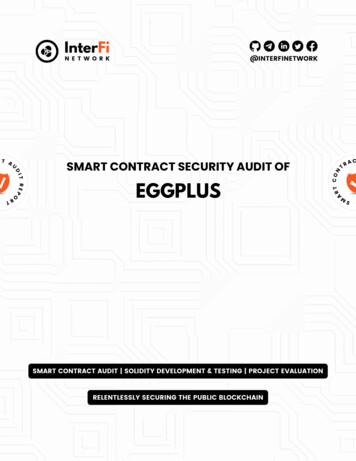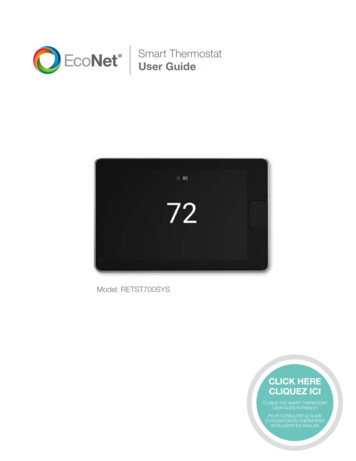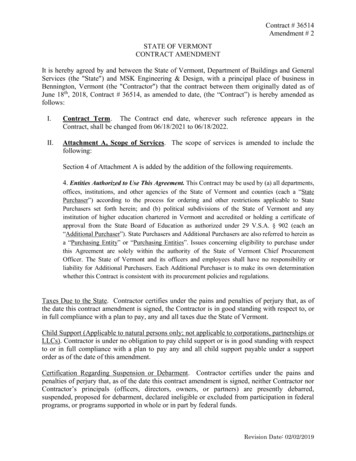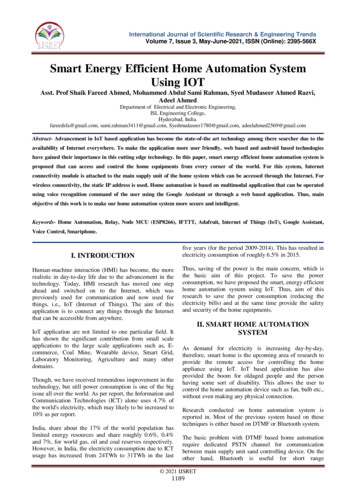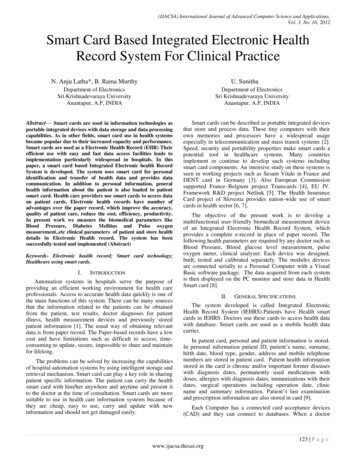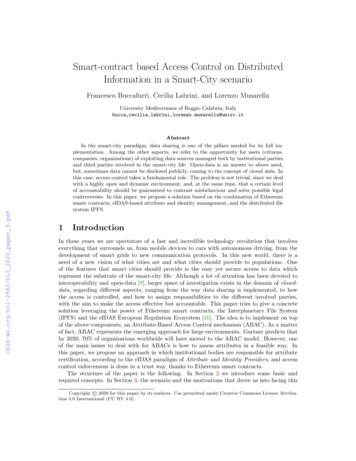
Transcription
Smart-contract based Access Control on DistributedInformation in a Smart-City scenarioFrancesco Buccafurri, Cecilia Labrini, and Lorenzo MusarellaUniversity Mediterranea of Reggio Calabria, .itAbstractIn the smart-city paradigm, data sharing is one of the pillars needed for its full implementation. Among the other aspects, we refer to the opportunity for users (citizens,companies, organizations) of exploiting data sources managed both by institutional partiesand third parties involved in the smart-city life. Open-data is an answer to above need,but, sometimes data cannot be disclosed publicly, coming to the concept of closed data. Inthis case, access control takes a fundamental role. The problem is not trivial, since we dealwith a highly open and dynamic environment, and, at the same time, that a certain levelof accountability should be guaranteed to contrast misbehaviour and solve possible legalcontroversies. In this paper, we propose a solution based on the combination of Ethereumsmart contracts, eIDAS-based attribute and identity management, and the distributed filesystem IPFS.1IntroductionIn these years we are spectators of a fast and incredible technology revolution that involveseverything that surrounds us, from mobile devices to cars with autonomous driving, from thedevelopment of smart grids to new communication protocols. In this new world, there is aneed of a new vision of what cities are and what cities should provide to populations. Oneof the features that smart cities should provide is the easy yet secure access to data whichrepresent the substrate of the smart-city life. Although a lot of attention has been devoted tointeroperability and open-data [9], larger space of investigation exists in the domain of closeddata, regarding different aspects, ranging from the way data sharing is implemented, to howthe access is controlled, and how to assign responsibilities to the different involved parties,with the aim to make the access effective but accountable. This paper tries to give a concretesolution leveraging the power of Ethereum smart contracts, the Interplanetary File System(IPFS) and the eIDAS European Regulation Ecosystem [26]. The idea is to implement on topof the above components, an Attribute-Based Access Control mechanism (ABAC). As a matterof fact, ABAC represents the emerging approach for large environments. Gartner predicts thatby 2020, 70% of organizations worldwide will have moved to the ABAC model. However, oneof the main issues to deal with for ABACs is how to assess attributes in a feasible way. Inthis paper, we propose an approach in which institutional bodies are responsible for attributecertification, according to the eIDAS paradigm of Attribute and Identity Providers, and accesscontrol enforcement is done in a trust way, thanks to Ethereum smart contracts.The structure of the paper is the following. In Section 2 we introduce some basic andrequired concepts. In Section 3, the scenario and the motivations that drove us into facing thisCopyright c 2020 for this paper by its authors. Use permitted under Creative Commons License Attribution 4.0 International (CC BY 4.0).
Smart-contract based Access Control on Distributed Information.Buccafurri, Labrini, and Musarellaproblem are described. Then, in Section 4, we explain the architecture of our proposal andthe actors involved in it. We briefly analyze, in Section 5, the most important security aspectsand properties of our solution. In Section 6, some features of the implementation phase of theproposal are described. In Section 7 we survey the related work. Finally, in Section 8 we drawthe conclusions and the we sketch future works.2BackgroundIn this section we present some background concepts to better introduce, later, our proposal.1. EthereumEthereum is a public blockchain-based platform that allows the development of decentralized applications (Dapps) able to interact with each other in a secure and fast way [13, 29].Ethereum provides a decentralized and Turing-complete virtual machine able to executescripts and code. In Ethereum, there are two different kinds of accounts: the ExternallyOwned Account (EOA) and the Contract Account (better known as Smart Contract). Theformer is controlled by a private key (like an account of the Bitcoin blockchain), whilethe latter is controlled by its code, which is executed by every peer of the blockchain sothat the output of the execution is well-known to them. Moreover, a smart contract canbe written easily thanks to Solidity, a high-level programming language that implementsthe Ethereum Virtual Machine bytecode [11].Smart contracts are used also as agreements between users that do not trust or do notknow each other and, for these reasons, they definitely represent the killer feature ofEthereum. Furthermore, everything that is on a smart contract is permanently stored inthe Ethereum blockchain to guarantee the traceability of actions.2. Attribute-Based Access Control (ABAC)Access control is one of the hottest and trend topics of the last decades in the IT world.Indeed, to guarantee a right, secure and non-invasive mechanism that enable or not theaccess to the resource is always necessary. In particular, an access control mechanismshould satisfy, among the others, the following properties: it does not have to allow nonauthorized people to access the resource and it does not have to deny authorized peoplenot to access the resource. The type of access must be subject of authorizations as well.There exist many families of access control, such as Mandatory Access Control and Discretional Access Control, for what concerns the flexibility of authorization rules, Role-BasedAccess Control, Context-Based Access Control, Attribute-Based Access Control, etc., forwhat concerns the way to associate authorizations to subjects.In particular, Attribute-Based Access Control (ABAC) is defined as an access controlmechanism in which authorization is computed evaluating the fulfillment of one (or more)required attribute. The National Institute of Standards and Technology (NIST) definesABAC as follow [17]: “An access control method where subject requests to perform operations on objects are granted or denied based on assigned attributes of the subject, assignedattributes of the object, environment conditions, and a set of policies that are specified interms of those attributes and conditions.”As a matter of facts, after some decades of supremacy Role-Based Access Control (RBAC),ABAC is emerging as definitely more suitable than RBAC to large environments, in which
Smart-contract based Access Control on Distributed Information.Buccafurri, Labrini, and Musarelladefined roles must be set by the management and associated with people, resulting in whatis known as role explosion. In our context (i.e., smart city), ABAC is the elective choice.3. Smart CityNowadays, cities face different problems and challenges to improve their citizens’ qualityof life [25]. Governments, communities, and businesses increasingly rely on technologyto overcome the problems that arise daily [28]. Smart cities can make an intelligentresponse to different kinds of needs, including public safety and services, industrial andcommercial activities, transportation, and healthcare [24]. In detail, a city becomes asmart city when it combines the usage of network infrastructure, software systems, serverinfrastructure, and client devices to better connect critical city infrastructure componentsand services. Smart cities are an effective integration of smart planning ideas, smartdevelopment approaches, and smart management methods. On the other hand, a citycannot be defined as smart if it adopts limited and sectorial improvements.Indeed, a smart city must involve different elements such as smart governance, smarteconomy, smart mobility, etc. Smart cities make use of new types of information andcommunications technology to support common sharing which is one of their most important characteristics. It is well-known that the features of blockchain technology maycontribute to smart city development through sharing services.4. InterPlanetary File System (IPFS)IPFS is a peer-to-peer distributed file system that connects all computing devices with thesame system of files [27]. It provides a high-throughput content-addressed block storagemodel, with content-addressed hyperlinks. IPFS employs content-addressing to uniquelyidentify each file in a global namespace connecting all devices. Furthermore, it identifies,verifies and transfers files relying on the cryptographic hashes of their contents [22]. It alsointegrates technologies such as self-certifying namespaces, an incentivized block exchange,and distributed hash tables (DHT), etc. IPFS is built around a decentralized system ofuser-operators who own a portion of the total data, creating a resilient system of filestorage and sharing. As a consequence of this decentralized approach, IPFS has not aunique point of failure, and nodes do not need to trust each other as well.The IPFS user, when uploads a file to the system, will have back a unique cryptographichash string (IPFS-identifier of the document) through which she/he can retrieve the fileevery time and everywhere. Indeed, it is not required that the user stores the originalfile in her/his devices, but it is enough to know the IPFS-identifier of the document toobtain it. The hash string can be seen as a Uniform Resource Locator (URL) of theWorld-Wide-Web.3Scenario and MotivationIn the widest interpretation of the concept of a smart city, one of the main challenges is toguarantee a secure, trusted and fast data sharing. This may have a significant impact bothin open-government policies that are crucial in smart cities [30], and in the smart fruition ofinformation to deliver complex services that need multiple data sources.In this scenario, it is fundamental to implement an access control mechanism that is ableto decide who can read what, by taking into account the fact that we operate in an openenvironment, in which interested subjects cannot be predetermined. It is worth noting that,
Smart-contract based Access Control on Distributed Information.Buccafurri, Labrini, and Musarellaalthough smart cities should provide open data, which are accessible with no limitation, alsoclosed data are relevant for the full implementation of smart-knowledge-based communities.Therefore, access control becomes necessary.To better explain, consider the following example. Suppose that some closed data areproduced by a smart city entity like a hospital or a court. Since we are talking about sensitivedata, it is reasonable to think of some policies for which only people belonging to the medicalboard (in the case of healthcare data) or lawyers (in the case of law data) can access.As seen above, there are many access control models but, among all, due to the open natureof our scenario, Attribute-Based Access Control (ABAC) seems the most suitable one becauseneither identities nor roles are able to capture all the conditions which should be satisfied bysubjects to access information. Moreover, ABAC allows us to implement anonymous-credentialmechanisms to avoid that sensitive data of subjects are disclosed to possibly untrusted partiesand, thus, to preserve privacy.Obviously, if we think about a smart city and its data it is clear that it is necessary toensure properties like accountability, privacy, trust and non-repudiability (among the others).In this sense, Ethereum blockchain perfectly fits with these requirements. Another motivationthat led us to choose Ethereum is that the mechanism of verification of attributes must betrusted. Furthermore, the usage of an Ethereum smart contract enforces the attribute-basedaccess control mechanism without any privacy leakage, since attribute-based authorizations areanonymous and prevent any disclosure of personal, sensitive, and not required information.Anyway, Ethereum, as every blockchain, is not the most suitable platform for sharing andstoring large files since the blockchain is replicated on many nodes and a lot of storage space isrequired without serving an immediate purpose [22]. Moreover, the blockchain becomes bloatedwith data that has to be propagated within the network and the price of operating blockchainnodes increases because more data needs to be processed, transferred and stored. File sharingplatforms can be leveraged to solve these problems. Users can easily share large files and stillbenefit from the blockchain.InterPlanetary File System (IPFS) is a particularly interesting protocol peer to peer filesharing platform that combines file sharing and hashes. Cryptographic hashes serve to securelyidentify a file’s content. IPFS makes it possible to store and share large files more efficiently andit is based on cryptographic hashes that can easily be stored on a blockchain. Unlike existingcloud storage, IPFS has the advantage that data is distributed and stored in different parts ofthe world and not on a central server [27]. Finally, a solution exploiting IPFS guarantees dataavailability.4Our ProposalIn this section, we propose our solution regarding the scenario discussed above.First, we define all actors involved in it, then we present all the steps needed to reach ourgoal.Our idea is the following. Suppose that the smart city produces, owns and provides datathat it wants to share not to everybody but only to who fulfills some requirements. To bemore concrete, but without loss of generality, we describe our solution in the healthcare setting,although it can be easily extended to every typical context of smart cities (e.g., transport,commercial and law data, etc.). In our proposal, we assume that documents stored on IPFSare already encrypted and, for this reason, objects of our access control authorizations are keysinstead of final resources.In our solution, we define the following actors:
Smart-contract based Access Control on Distributed Information.Buccafurri, Labrini, and Musarella User U , a citizen that asks for data; Identity Provider IP , whose task is the management and verification of user identities; Attribute Provider AP , whose task is the management and verification of user attributes; Access Service Provider ASP ; Publish Smart Contract P SC, an Ethereum Smart Contract used for the publication ofdocuments on IPFS; Access Smart Contract ASC, an Ethereum Smart Contract used for verifying the policyand, where appropriate, for granting the key for the decryption of the document; Oracle O, that is used by ASC for checking the validity of the certificate of U ; Content Manager CM , who is in charge of encrypting documents, publishing them onIPFS, associating them to the right policy and addressing the key-request when U fulfillsits requirements; IPFS, used for storing data in a distributed way; Ethereum, a public blockchain allowing the development of smart contracts.Once defined all entities involved in our proposal, let’s describe the steps of our solution:1. Policy SetupIn this first phase, the CM associates the document di with the policy p̂. If p̂ does notexists, CM will generate it compliant with the XACML standard.In particular, every category has a set of attributes related to and, as a consequence, adifferent policy. In our scenario, we refer to the category of healthcare data, where, forthe sake of presentation, the attribute to be fulfilled is to be a doctor.2. EncryptionCM encrypts di with a symmetric encryption function (such AES) by using the keyrelated to the policy associated with healthcare data. Indeed, in accordance with theabove, every category (and every policy) has a different encryption key. Let us denote byk̂ the key associated with the policy p̂. Now, CM obtains the encrypted document ei .3. PublicationThe goal of this step is to publish on IPFS the encrypted document ei and the relatedpolicy p̂. This could be achieved through different ways. Indeed, CM could simply publishit directly with an IPFS client. Anyway, accordingly to the accountability features aimedby our proposal, we allow the publication only trough the Ethereum smart contract.In detail, CM calls a function of the P SC through her/his Ethereum address ET HCMwith ei as input obtaining as output the IPFS-hash hi related to ei . At the same time,CM calls another function of the same smart contract P SC to publish on IPFS the policyp̂, if it still does not exist in the Ethereum environment, thus obtaining the IPFS-hashhp̂ .At this point, CM maps hi with the corresponding policy hp̂ on the P SC. The result isa mapping between the policy p̂ and the list of documents associated with. Furthermore,there is a mapping between the area of interest (in this case, healthcare) and p̂.
Smart-contract based Access Control on Distributed Information.Buccafurri, Labrini, and Musarella4. Attribute VerificationIn this phase, the user U requests to ASC the policy that she/he has to satisfy relatedto healthcare, obtaining hp̂ . Now, similarly to the Publication phase, U could obtain thedocument directly with an IPFS-client, but again, our protocol enforces U to get it onlyvia ASC. At this point, U knows p̂ and she/he can see that the attribute required is to bea doctor. For the assessment of the attributes owned by users, we apply an eIDAS-basedapproach [26], in which a SAML-2 authentication process is established to involve bothan Identity Provider and one or more Attribute Providers which are institutional entitiesresponsible for providing information (like title, licences, qualifications, age, etc.) aboutdigital identities. To be compliant with real-life regulations, we cannot imagine that everyuser plays the role of the service provider in an eIDAS authentication loop. Therefore,we introduce an intermediate service, called Access Service Provider (ASP ), needed toperform the authentication request and to obtain the valid corresponding assertion. Indetail: U goes to ASP to request, by playing the role of Service Provider the assertion inwhich there is the information certifying the attribute to be a doctor; through a SAML2-compliant schema, ASP forwards the request to the IdentityProvider IP ; after that, IP contacts the Attribute Provider AP (in the use case, the medicalboard) asking for the certification of the attribute being a doctor; now, AP sends the reply to IP , which will contact ASP to communicate the information obtained through an assertion. Finally, ASP returns to U the assertion andthe nonce related to. In particular, the nonce allows applications to correlate theidentifier of the assertion with the initial authentication request and it is used alsoto avoid replay attacks (see Section 5).ET HU sends a transaction to ASC calling a function in which she/he puts the hashedidentifier of the assertion and the nonce as input. The smart contract, now, has to verifythe validity of the assertion and, as a consequence, the real possession of the attributerequired by the policy p̂. To do that, ASC invokes the Oracle O, that is in charge ofchecking the overall validity of the previous steps with IP .If the check succeeds, ASC emits an event in which it confirms the satisfaction of thepolicy.5. Key GrantingIn this step, CM sees the event of success on the blockchain (it can be done via a clientapplication that is able to show, and possibly filter, events) and CM sends a transaction blockchain to ET HU with the information about k̂. Obviously, before to send thetransaction, CM should encrypt the key to prevent from its disclosure to all blockchain.UTo reach this goal, CM encrypts k̂ with U ’s public key, obtaining Epk(k̂). The result isan ethereum transaction from CM to ET HU through the ASC having as input dataUEpk(k̂). We remind that input data is an optional field of an ethereum transaction thatcan be used to share other information.Finally, U is the only one who can decrypt, with her/his private key, the chipered keyUEpk(k̂). After the derivation of k̂, U is able to dechiper also ei , thus obtaining di .
Smart-contract based Access Control on Distributed Information.5Buccafurri, Labrini, and MusarellaSecurity AspectsIn this section, we briefly analyze the main security aspects that are involved in our proposal.This paper, indeed, can be view as a position paper presenting some results obtained in anindustrial research project still alive. A more detailed analysis is then forwarded to the nextsteps of our work.Let us begin with the definition of the adversarial model, that is particularly relevant for ourproposal because by modeling the role of attackers, with their capabilities and goals, we couldhelp to improve the cyber defense [12] and, since we are facing the case of closed data in thesmart city scenario, it is necessary to ensure that some fundamental security evaluations arevalid. In detail, in our proposal, we assumed that the Content Manager, the Identity Providerand the Attribute Provider are trusted parties and that the attacker can be either a user or theAccess Service Provider.In particular, the Access Service Provider could operate in a malicious way since it couldgive the wrong assertion to the wrong users. Anyway, this attack is contrasted by using theSAML-2 standard because the Authentication Request and the Authentication Response mustcoincide, so the ASP is not able to give the wrong response to the wrong applicant.In sum, we do not require the ASP more trust then that one required by the eIDAS regulation. In addition to the standard security properties and assumptions, such as those onesrelated to the Ethereum blockchain and IPFS protocols, we assume that user’s secret information and data are not disclosed to the public world and that users do not collude each other aswell.The goal of the attacker is to break, at least, one of the following secure properties: availability, non-repudiation, accountability, integrity and confidentiality.In our proposal, data are stored on IPFS while their identifiers are stored on the Ethereumblockchain. This combination of these two technologies contrasts attacks on availability. Indeed,the usage of IPFS avoids the central and unique point of failure, since data are duplicated onmultiple and random IPFS peers. Moreover, the DoS attack, in which the attacker floods theEthereum network with a huge amount of requests, would be very expensive because everyEthereum transaction and every call to a function of an Ethereum smart contract has a cost interms of gas.Non-repudiation is obtained. In fact, every action is logged into Ethereum and it can beverified at any time and, in addition, Ethereum transactions are not editable after been mined.They are also signed by the Ethereum private key, that is known and kept only by the ownerof the address. Furthermore, non-repudiation is ensured by our protocol also during the phasesinvolving the publication of documents and policies on IPFS and the downloading of such filesfrom IPFS. In particular, although these operations could be carried out by using a standardIPFS client application, we implemented an alternative approach, based on smart contracts,enforcing the non-repudiability of the overall protocol.We can distinguish two different domains of interest: that one on the blockchain and theother one off-chain. Concerning the former, accountability is ensured similarly to the nonrepudiation property. Instead, if we think to the off-chain side of our proposal, accountabilityis reached because only the Identity Provider and the Attribute Provider(s) know exactly thelink between the identity of the user and its related Ethereum address. So, if for any reasonit is necessary to reveal this mapping, it could be done by merging information from differentparties.Data integrity is, again, reached thanks to IPFS by the usage of the IPFS-cryptographichash that is carried out for every document published on the InterPlanetary File System.
Smart-contract based Access Control on Distributed Information.Buccafurri, Labrini, and MusarellaConfidentiality is obtained as well, because sensitive and closed data are chipered by the ContentManager and the decryption key is given only to those users that fulfill the policy associatedwith them. Furthermore, the Content Manager, before sending to the user the key, encrypts itwith the ethereum public key of herself/himself, that can be easily derived from the Ethereumaddress. So, even if the Content Manager sends the key by using Ethereum, nobody can actuallyunderstand it excepts for the interested user.Finally, our protocol reaches the goal of privacy requirement, since the Content Manageris not aware of personal and sensitive information about users except for their attributes andtheir Ethereum addresses. In this case, the level of protection of these data is that one relatedto the pseudonymity provided by the Ethereum blockchain itself, that is not full. However, ifthe user wants to preserve better her/his privacy, she/he can generate a new Ethereum walletfor every operation, making attacks on pseudonymity not realizable anymore.6Implementation IssuesTo implement our proposal, we used many different technologies and framework to integrateIPFS and XACML with ethereum smart contracts.In particular, these are, among the others, the most relevant ones: RemixIDE [3], an online IDE for the development of ethereum smart contracts; Truffle Suite [4], a suite of tools useful for interfacing smart contracts (e.g., Ganache); Metamask [1], a browser extension that allows us to run dApps on the browser withoutrunning a full Ethereum node; Web3.js [5], a lightweight JavaScript library for integration with Ethereum clients; Provable (ex Oraclize) [2], the most known oracle used for Ethereum.For the sake of presentation, we show only the most interesting details we faced during theimplementation of our solution and we miss some other details.First, we developed a JavaScript web-page containing a form allowing the submission of fileson IPFS that interfaces with the smart contract showed in Figure 1 in a transparent way.12345678910111213pragma s o l i d i t y0.5.8;contract S i m p l e S t o r a g e {string ipfsHash ;function s e t ( s t r i n g memory x ) public {ipfsHash x ;}function g e t ( ) public view returns ( s t r i n g memory) {return i p f s H a s h ;}}Figure 1: Code of the smart contract SimpleStorage used to publish on IPFSMoreover, the web-page returns the IPFS-cryptographic-hash identifier of the documentsubmitted and all this operation is permanently stored in Ethereum. This is done thanks tothe JavaScript code shown in Figure 2.
Smart-contract based Access Control on Distributed Information.Buccafurri, Labrini, and MusarellaFigure 2: Portion of the code of App.jsIn particular, after the connection with the library web3js, captureFile is the function tobuffering the file once submitted on IPFS and onSubmit is used for the acquisition of the hashcomputed by IPFS. The operation carried out for the submission of the policy on IPFS viasmart contract are the same. In Figure 3 there is the portion of the smart contract that is incharge of mapping the IPFS-hash of the document and its related IPFS-hash policy.123456789101112131415161718address c o n t e n t m a n a g e r ;mapping ( s t r i n g F i l e ) public f i l e M a p ;s t r i n g [ ] public f i l e P o l i c y ;constructor ( ) public {c o n t e n t m a n a g e r msg . sender ;}modifier onlyCM ( ) {require ( c o n t e n t m a n a g e r msg . sender ) ;;}function c r e a t e M a p p i n g ( s t r i n g memory i p f s H a s h , s t r i n g memory p o l i c y H a s h ) public onlyCM{fileMap [ ipfsHash ] . ipfsHash policyHash ;fileMap [ ipfsHash ] . policyHash policyHash ;f i l e P o l i c y . push ( i p f s H a s h ) ;}Figure 3: Code of the smart contract for the mapping between document and its policy
Smart-contract based Access Control on Distributed Information.Buccafurri, Labrini, and MusarellaIt is worth noting that the function createMapping can be called only by the ContentManager (in this case, the deployer of the smart contract) thanks to the modifier onlyCM.Indeed, the modifier is a function of Solidity that, when it is added to the declaration of afunction, limits the access to the function itself to those users who satisfy its requests.Another interesting aspect about the implementation regards the request of the policy fromthe Ethereum smart contract to the IPFS network because the policy is written with XACML,an XML-like language and there is need to parse the result. This has been solved as shown inFigure 4.12345678910111213141516171819202122pragma s o l i d i t y0.5.8;import " . / O r a c l i z e . s o l " ;contract P o l i c y i s u s i n g O r a c l i z e {bytes32 public o r a c l i z e I D ;s t r i n g public r e s u l t s ;event L o g O r a c l i z e R e s u l t ( s t r i n g r e s u l t ) ;function i p f s ( ) payable {OAR O r a c l i z e A d d r R e s o l v e r I ( " a d d r e s s " ) ;}function g e t A t t r i b u t e ( ) payable {o r a c l i z e q u e r y ( " U R L " , " x m l ( h t t p s : / / i p f s . i o / i p f s / " IPFS hash i d e n t i f i e r " ) .AttributeValue " ) ;}functionc a l l b a c k ( bytes32 myid , s t r i n g r e s u l t ) {results result ;LogOraclizeResult ( r e s u l t ) ;}}Figure 4: Code of the smart contract query with parser XMLNow that the smart contract has obtained the attribute (or attributes) required by thepolicy, it compares it to the attribute that is in the certificate presented by the user to the samesmart contract. If the information completely overlaps, then the Content Manager generatesa transaction to the user in which she/he specifies the key associated with the policy afterencrypting it with the user’s ethereum public key.7Related WorkIn this section, we investigate the state of the art regardi
In particular, Attribute-Based Access Control (ABAC) is de ned as an access control mechanism in which authorization is computed evaluating the ful llment of one (or more) required attribute. The National Institute of Standards and Technology (NIST) de nes ABAC as follow [17]: \An access control method where subject requests to perform opera-



